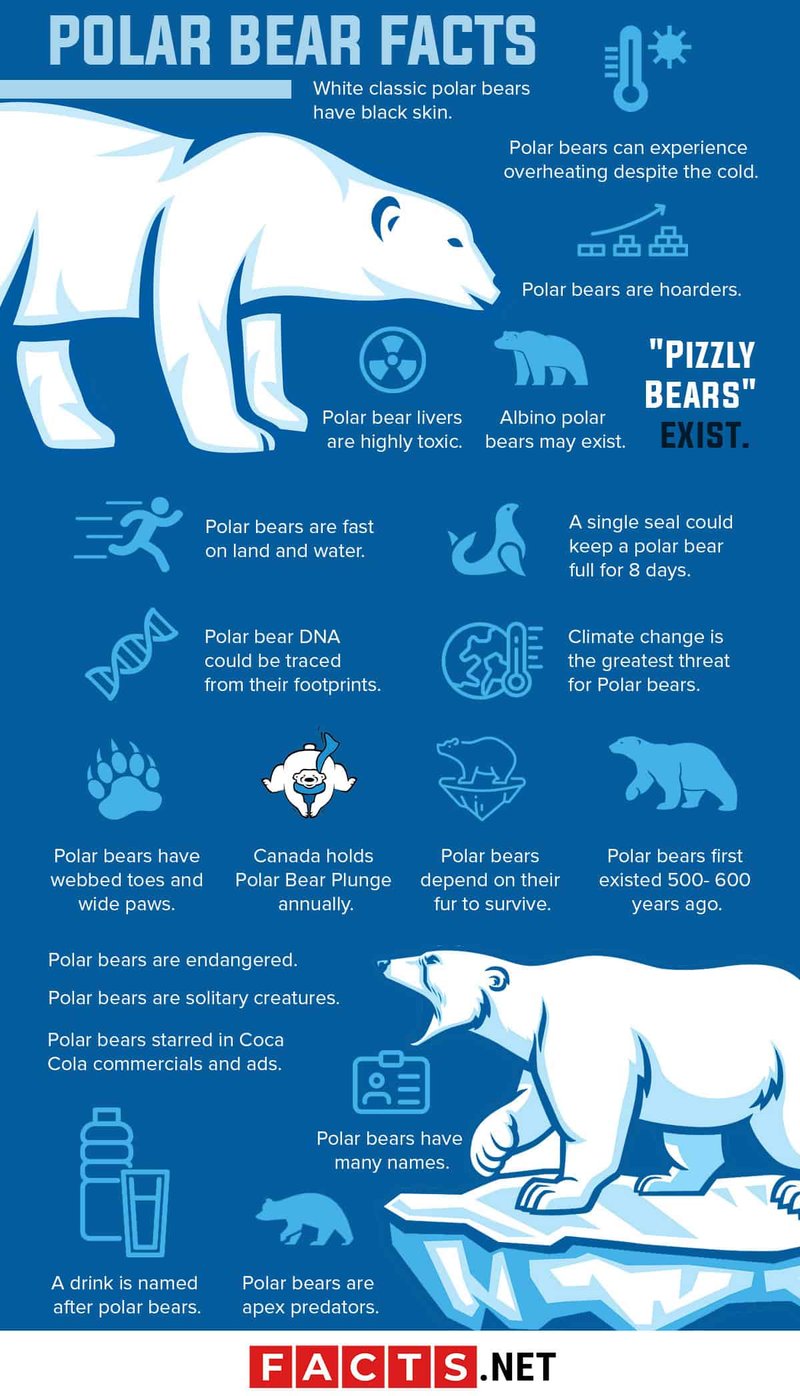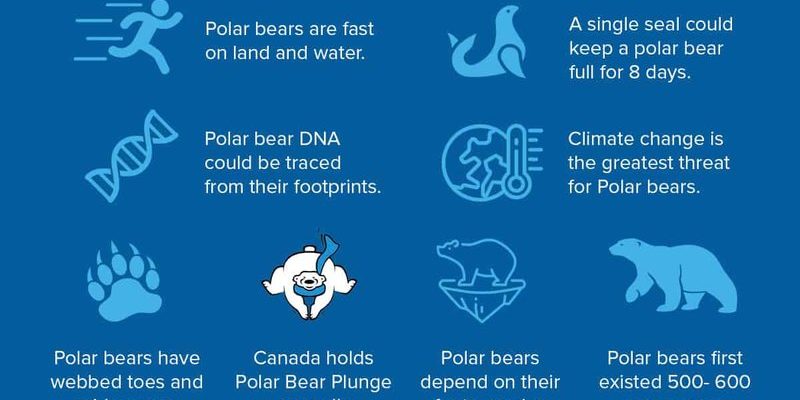
These bears aren’t just beautiful; they play a vital role in their ecosystem. Understanding polar bears helps us appreciate the delicate balance of nature and the impacts of climate change. Whether you’re a budding wildlife enthusiast or a curious reader, these facts will give you a new perspective on these magnificent creatures.
1. Polar Bears Are Actually Marine Mammals
You might think of polar bears as just another land animal, but here’s the thing: they are classified as marine mammals. Yes, you read that right! They spend most of their life on the sea ice of the Arctic Ocean. Polar bears are expert swimmers and can swim for several miles at a time. In fact, they can paddle for up to 60 miles without resting!
Their large, paddle-like front paws help them navigate the icy waters, making them perfectly adapted for life in and around the ocean. When they hunt for seals, which are their primary food source, they often wait by holes in the ice, ready to pounce. So, the next time you picture a polar bear, remember they’re not just wandering on land but are also masters of the sea!
2. They Have a Thick Layer of Insulation
Polar bears are built for the cold. Their bodies come equipped with a thick layer of blubber—up to four inches thick! This blubber acts like a cozy winter coat, keeping them warm in frigid temperatures that can drop as low as -40°F (-40°C).
But that’s not all; they also have a dense fur coat, which adds to their insulation. The fur isn’t just white; it’s actually transparent and hollow. This helps reflect light, making them blend in with their snowy surroundings. If you’ve ever wondered how these bears manage the biting Arctic cold, now you know: they’re nature’s ultimate cozy animals!
3. They’re Top Predators in Their Habitat
In the Arctic ecosystem, polar bears stand at the top of the food chain. Their primary prey is seals, which they hunt on the sea ice. These bears have keen senses, especially their sense of smell, which allows them to detect a seal’s breathing hole from nearly a mile away.
When they hunt, they often use a technique known as “still-hunting.” This is where they slowly stalk a seal’s breathing hole, waiting for the right moment to strike. It’s like a game of patience and skill! So, polar bears don’t just rely on brute strength; they also have strategies that make them incredibly effective hunters.
4. They Can Overheat Too!
It might sound surprising, but polar bears can actually overheat! With all that insulation, they are well-equipped for icy temperatures, but in warmer weather or during intense physical activities, they can struggle to cool down.
When it’s sunny or they’re running around, they might take a dip in the icy waters to chill out. Alternatively, they’ll often rest on the ice or even dig shallow pits to lie in. It’s as if they have their own air conditioning system to help them regulate their body temperature. This adaptability shows just how well they cope with the extremes of their environment.
5. Polar Bears Are Solitary Animals
Unlike other animals that thrive in packs or groups, polar bears are mostly solitary. Adult bears usually roam alone, except during mating season or when a mother is raising her cubs. This solitary nature helps reduce competition for food and resources in their harsh environment.
Mothers are incredibly devoted, though. A female polar bear will typically give birth to one to three cubs, and she’ll fiercely protect them during their early years. The cubs stay with their mom for about two to three years, learning essential survival skills before they venture out on their own. It’s fascinating to see how these social habits shape their behavior and survival rates!
6. They Have a Unique Hunting Strategy
As mentioned earlier, polar bears are skilled hunters, but they also have a unique strategy that sets them apart. They rely heavily on the sea ice for hunting seals, but when that ice melts due to climate change, it poses a significant threat to their survival.
During the late summer months, when melting ice makes hunting increasingly difficult, polar bears can enter a state called “walking hibernation.” This is where they conserve energy, slowing their metabolism to survive when food is scarce. It’s an incredible adaptation, but it also highlights the challenges they face in a warming world.
7. Their Coloration Isn’t Just for Show
The white fur may look beautiful, but it serves a purpose beyond just aesthetics. Polar bears’ fur acts as camouflage in a snowy environment, helping them sneak up on unsuspecting seals. The transparent hairs scatter light, making them blend seamlessly into their surroundings.
Moreover, their skin beneath all that fur is black. This is designed to absorb sunlight, helping them maintain warmth. So, every aspect of their coloration is a clever adaptation that enhances their chances of survival in a challenging habitat. Isn’t nature clever?
8. They Communicate in Various Ways
Polar bears are not just strong and solitary; they also have a rich set of communications. They use a combination of vocalizations, body language, and even scent to express themselves. For instance, a mother may grunt or make a low growl to communicate with her cubs, signaling that it’s time to follow her or that danger is near.
Scent marking is another crucial aspect of their communication. They often rub their bodies against ice or snow to leave their scent, which can convey information about their identity or reproductive status. This complex communication system is essential for their social interactions, especially during mating seasons or in avoiding conflicts.
9. Climate Change Threatens Their Survival
Unfortunately, the very habitat that polar bears depend on is changing rapidly due to climate change. The melting of sea ice affects their ability to hunt seals, leading to food shortages. As ice continues to retreat, these bears are forced to swim longer distances to find food, which can be exhausting and dangerous.
Conservation efforts are crucial to protect these incredible animals. Raising awareness about climate change and its impact on polar bears is more important than ever. Every little bit counts, from reducing carbon footprints to supporting organizations dedicated to preserving Arctic habitats.
10. They’re a Symbol of Arctic Conservation
Polar bears have become emblematic of wildlife conservation. Their plight highlights the broader issues of climate change and habitat destruction. Efforts to protect polar bears can lead to benefits for many other species in the Arctic ecosystem.
By focusing on preserving their habitat, we also help maintain the balance of the ecosystem itself. So, when you think of polar bears, remember they are more than just beautiful creatures; they represent a call to action for environmental awareness and preservation.
In conclusion, polar bears are remarkable animals that inspire fascination and concern. From their unique adaptations to their critical role in their ecosystem, understanding these creatures deepens our appreciation for the natural world. As we learn more about them, we can also take steps to protect their future. Together, let’s ensure that these magnificent animals continue to thrive in the Arctic for generations to come.

